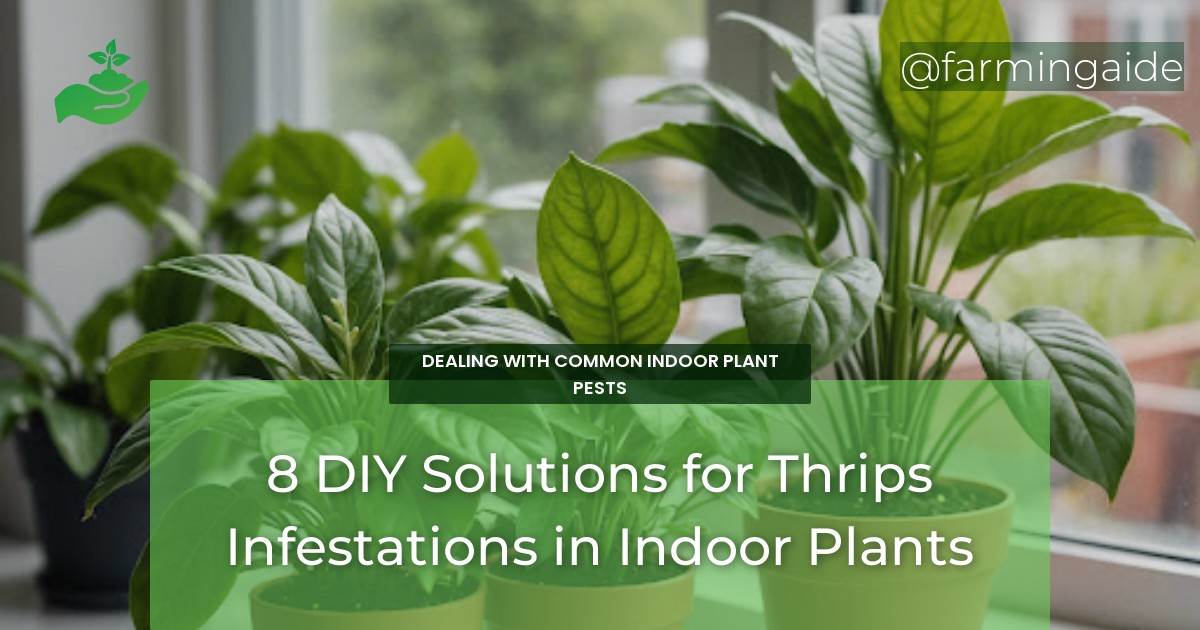Are you tired of dealing with pesky thrips infestations in your indoor plants? These tiny insects can cause significant damage to your beloved greenery, leaving behind a trail of white speckles and weakened leaves. However, with the right DIY solutions and preventive measures, you can keep thrips at bay and maintain a thriving indoor garden. In this article, we’ll delve into the world of thrips infestations, exploring the signs, preventive measures, and natural remedies to combat these unwanted pests.
Key Takeaways
- Thrips can cause significant damage to indoor plants, leading to white speckles and weakened leaves.
- Preventive measures such as ideal plant care practices and creating a thrips-resistant environment can help mitigate infestations.
- Natural remedies like homemade insecticidal soap and neem oil can be used to combat thrips.
- Biological control methods, including introducing beneficial insects and using nematodes, can provide effective thrip control.
- Physical removal techniques like manual thrip removal and washing plants can also be employed to eliminate thrips.
Understanding Thrips and Their Impact on Indoor Plants
Thrips are tiny, flying insects that feed on plant sap, causing damage to leaves, stems, and flowers. These pests can lead to reduced plant growth, distorted leaves, and a weakened immune system, making your plants more susceptible to diseases. To effectively combat thrips, it’s essential to understand their life cycle and habits.
Thrips can multiply rapidly, with females laying up to 200 eggs on the surface of leaves or stems. The eggs hatch into larvae, which feed on plant sap before entering a pupal stage. Adult thrips emerge after a few weeks, starting the cycle anew.
What are Thrips?
Thrips are members of the order Thysanoptera, with over 6,000 known species. These insects are typically between 1-15 mm in length, with most species being yellow, white, or transparent. Thrips have distinctive fringed wings and feed on plant sap, pollen, or other small insects.
In indoor gardens, thrips are often introduced through contaminated soil, infected plants, or on people’s clothing. Once established, they can spread rapidly, infesting multiple plants.
Signs of Thrips Infestation
Identifying thrips infestations early on is crucial for effective control. Keep an eye out for these common signs:
| Sign | Description |
|---|---|
| White or silver speckles on leaves | Thrips feeding on plant sap, leaving behind characteristic white or silver speckles. |
| Distorted or stunted leaves | Thrips feeding can cause leaves to become distorted, stunted, or curled. |
| Black specks or frass on leaves | Thrips excrete a dark, sticky substance, which can attract ants and wasps. |
| Premature defoliation | Severe thrips infestations can lead to premature defoliation or leaf drop. |
Preventive Measures to Avoid Thrips Infestation
Taking proactive steps to prevent thrips infestations can save you time, effort, and money in the long run. By adopting ideal plant care practices and creating a thrips-resistant environment, you can reduce the likelihood of infestation.
ALSO READ
Ideal Plant Care Practices
Healthy plants are better equipped to resist thrips infestations. Ensure your plants receive:
- Adequate light and temperature
- Proper watering and humidity
- Balanced fertilization and pruning
By providing optimal growing conditions, you can strengthen your plants’ natural defenses against thrips.
Creating a Thrips-Resistant Environment
To minimize the risk of thrips infestation, consider the following:
- Quarantine new plants for at least 2-3 weeks before introducing them to your indoor garden.
- Use a fine-mesh screen or fine-netted bag to cover plants, preventing adult thrips from reaching them.
- Avoid over-fertilizing, as this can attract thrips.
- Regularly inspect your plants for signs of thrips infestation.
By combining these preventive measures, you can significantly reduce the likelihood of thrips infestation in your indoor garden.
Natural Remedies to Combat Thrips
If you do encounter thrips, don’t panic! There are several natural remedies and DIY solutions to combat these pests.
ALSO READ
Homemade Insecticidal Soap
Mix 1 tablespoon of mild liquid soap with 1 quart of water, and spray the solution directly on plants. This homemade insecticidal soap can help control thrips populations.
For a more potent solution, combine 1 tablespoon of neem oil with 1 quart of water and spray on plants.
Using Neem Oil as a Thrips Repellent
Neem oil is a natural insecticide that can be used to repel thrips. Mix 2 tablespoons of neem oil with 1 quart of water and spray on plants. Repeat every 7-10 days to maintain effectiveness.
Biological Control Methods for Thrips
Introduce beneficial insects or use nematodes to control thrips populations naturally.
Introducing Beneficial Insects
Encourage natural predators, such as ladybugs or lacewings, to prey on thrips. These beneficial insects can be purchased online or at local gardening stores.
Using Nematodes to Control Thrips
Steinernema feltiae nematodes are a natural, non-toxic way to control thrips. These microscopic worms attack and kill thrips, providing long-term control.
Physical Removal Techniques for Thrips
In addition to natural remedies and biological control methods, physical removal techniques can be employed to eliminate thrips.
Manual Thrips Removal
Inspect your plants regularly, manually removing any thrips or eggs you find. Use a small brush or cotton swab to gently remove thrips from plant surfaces.
Washing Plants to Remove Thrips
Gently wash plants with a mild soap solution (1 tablespoon of mild liquid soap per 1 quart of water) to remove thrips and eggs. Be cautious not to damage plant leaves or stems.
Conclusion: Maintaining a Thrips-Free Indoor Garden
By understanding thrips, adopting preventive measures, and employing natural remedies and biological control methods, you can maintain a thriving, thrips-free indoor garden. Remember to stay vigilant, regularly inspecting your plants for signs of infestation and taking prompt action when necessary. With persistence and the right strategies, you can enjoy a beautiful, pest-free indoor garden.


